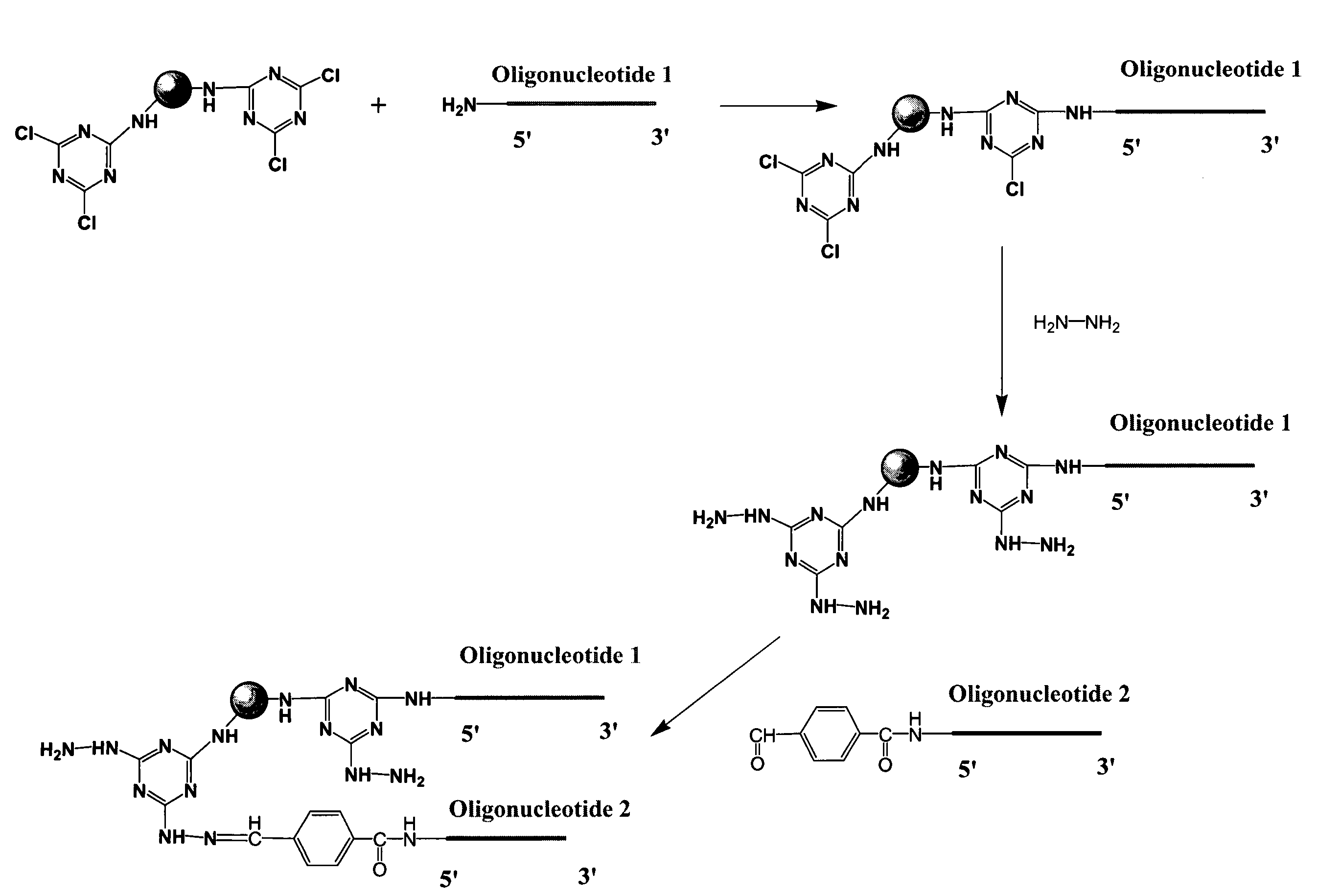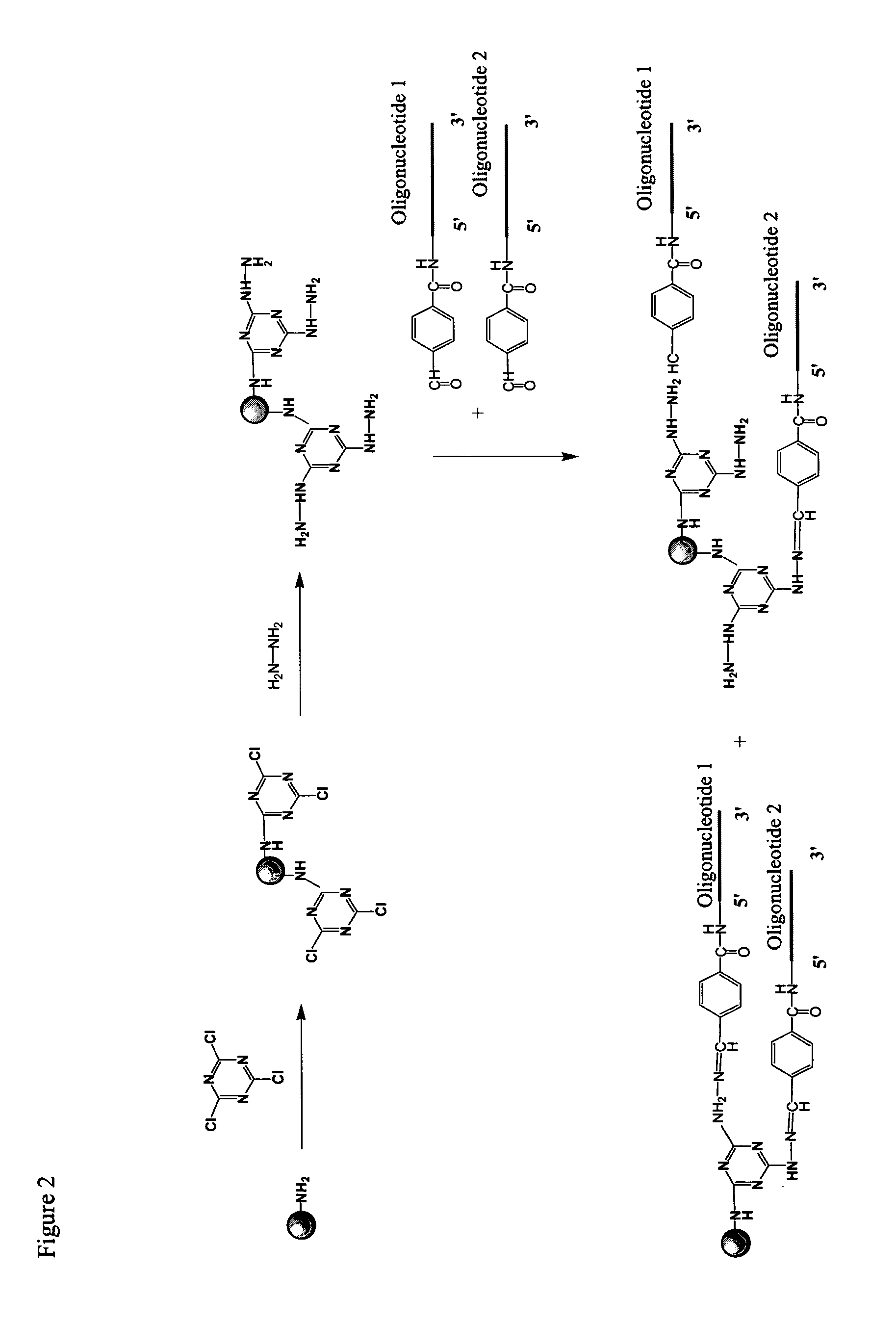Methods of attaching biological compounds to solid supports using triazine
a technology of triazine and solid supports, which is applied in the field of biologically active compounds, can solve the problems of cumbersome methods, inability to introduce different sequences onto the same solid surface, and inability to achieve the task at considerable time and cost to the user
- Summary
- Abstract
- Description
- Claims
- Application Information
AI Technical Summary
Benefits of technology
Problems solved by technology
Method used
Image
Examples
example 1
Hydrazine Bead Preparation
[0173]Cyanuric chloride activated beads were prepared as follows. 10 g of amino-modified beads were suspended with 20 μL of acetonitrile. Then 0.8 mL of N,N-diisopropylethylamine (DiPEA) and 100 mg of cyanuric chloride were added to the bead suspension. The reaction was mixed by vortexing and shaking at room temperature for 2 hrs. After the reaction, the bead solution was centrifuged and the supernatant removed. The beads were then washed with 100 μL of acetonitrile three times.
[0174]The beads were washed six times with DMF. For this and the following washes solvent was added to reach 10% bead solid content solution. The beads were shaken with 2% hydrazine solution in DMF overnight at room temperature using 10% bead solid content. Beads were then washed six times with DMF. The hydrazine beads were stored as a 10% bead solid content solution in DMF at room temperature or used directly. In addition to DMF, this chemistry works well with other solvents, such a...
example 2
Immobilization of Aldehyde Group Containing Oligonucleotides on Hydrazine Beads
[0175]Beads were prepared as described in Example 1. Beads were washed one time with 100 mM Na-citrate buffer, 3 M NaCl, pH 5.0. An aldehyde containing oligonucleotide called sequence 13 (25mer, 2-4 nmols of oligonucleotide per one mg of beads) was added to the washed beads in 100 mM Na-citrate buffer, 3 M NaCl, pH 5.0. The mixture was shaken overnight at room temperature using 10% bead solid content. The beads were then washed six times with water, followed by three washes with ethanol. Beads were stored as a 10% bead solid content solution in ethanol.
example 3
Sequential Immobilization of Amino Group Containing Oligonucleotides and Aldehyde Group Containing Oligonucleotides using Hydrazine Beads
[0176]Amino group containing oligonucleotides were reacted at room temperature, overnight, in aqueous buffer with cyanuric chloride modified beads, prepared as described in Example 1. Beads were washed with aqueous buffer and then ethanol. Following attachment of amino group containing oligonucleotides to the beads, aldehyde group containing oligonucleotides were immobilized as described in Example I.
[0177]Activity of the beads was evaluated using a hybridization assay in which fluorescently labeled oligonucleotide probes, having sequences complementary to the immobilized olionulceotides, were hybridized to the beads and detected in a fluorescent activated cell sorter (FACS). When sequential two-attachment chemistry is used, the hybridization intensities for the first (9mer, attached using amino group containing oligonucleotide) and second attachme...
PUM
 Login to View More
Login to View More Abstract
Description
Claims
Application Information
 Login to View More
Login to View More - R&D
- Intellectual Property
- Life Sciences
- Materials
- Tech Scout
- Unparalleled Data Quality
- Higher Quality Content
- 60% Fewer Hallucinations
Browse by: Latest US Patents, China's latest patents, Technical Efficacy Thesaurus, Application Domain, Technology Topic, Popular Technical Reports.
© 2025 PatSnap. All rights reserved.Legal|Privacy policy|Modern Slavery Act Transparency Statement|Sitemap|About US| Contact US: help@patsnap.com



